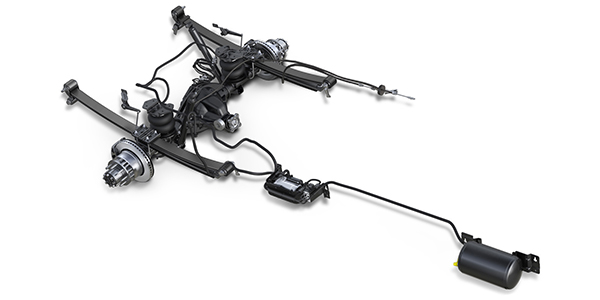Dodge introduced a four-corner air ride system for the 2013 RAM 1500 series of trucks. These systems are typically found on high-end European sedans, but the engineers saw that it could add functionality and comfort to a pickup. The also realized that air ride could improve fuel economy by improving aerodynamics.

The system can be controlled manually and has four settings:
• Off-Road 2 (OR2) = 2” lift
• Off-Road 1 (OR1) = 1.2” lift
• Aero Mode = -1.1” lower
• Entry/Exit Mode = -2.1” lower
The secret to diagnosing problems comes down to knowing what criteria the system uses to regulate the compressor/reservoir and having a scan tool that can interpret the information.
The Dodge does not use the compressor to directly fill the air bladders. Instead, the compressor will supply air to a reservoir that is used to fill the bladders. The reservoir is equipped with a pressure sensor and valves to send compressed air to the spring and exhaust excess pressure.
Do not work on any reservoir unless the system is allowed to depressurize before performing any repairs. The system can run at pressures as high as 220 psi. The Dodge system requires the use of a scan tool to release the pressure and under certain conditions, re-pressurize the system. Typically, the system will not need to be repressurized from an external source. Dodge has a special tool (#10427B) for the process, and they recommend using nitrogen for the first fill.
The reservoir is located on the passenger-side outside frame rail or above the spare tire carrier. It is rare for the tank to develop a leak, but it is common in the air-line connections. The lines can’t be patched or spliced; the only option is to replace the entire hose.
The compressor can be located behind the right rear tire under the bed, or on some larger models, it will be found on the passenger-side frame rail. Mounted next to the compressor is a block of valves that control pressure to the air springs. The block has six solenoids. Each spring has a solenoid, and the other two solenoids are for pressure and exhaust from the compressor.
The air-ride system control module looks for information like vehicle speed, ambient air temperature, ride height and the selected suspension mode. From this information, a system can calculate how long the compressor should run to fill the reservoir. If it is taking too long to fill a reservoir, the air-ride module will set a code, alert the driver, and put the system in a safe mode. The safe mode will not change the height of the suspension to conserve pressure. It also looks at the door switches to determine if it is safe to lift or lower the truck.
The codes for this type of problem will typically include the words “replenish,”“reservoir,” “overheat,”“no pressure increase”or“timed out.” There are two main culprits for these codes — a weak compressor or a leak in the system. It is possible that a sensor in the reservoir is faulty, but this is extremely rare. Dodge has mounted the temperature sensor on the compressor to measure the temperature of the compressor body that contains the piston.
COMPRESSOR DIAGNOSTICS
All air-ride systems are unable to do two things. First, they can’t measure wear in the compressor. As a compressor runs, the ring wears, and the compressor is unable to generate enough pressure to operate the system. The control module can’t measure the wear on the ring. Second, air-ride systems can’t detect the location of leaks in the system. However, what air-ride systems can measure is compressor run time.
The control module will not immediately turn on the compressor when the engine is started and will trim the suspension from the air in the reservoir.
All four corner systems are using air from the reservoir even if the car is parked. This is because as the vehicle cools, the air volume and pressure in the bladders and reservoir will decrease. The system will trim the ride height to make sure the truck is not sitting on the ground when the driver returns to the truck in the morning. Also, some systems will keep a level ride height if the truck is parked on an uneven surface, or the vehicle is unlocked and a load is placed in the trunk. But, the systems will never turn on the compressor to make a key-off correction.
Most systems have fail-safe modes that preserve the system until it can be serviced. This means that the control module will not allow a compressor meltdown if there is a leak. Also, most units will maintain minimum pressure or height in order to prevent a bladder from fully compressing and the suspension from bottoming out.
Before a vehicle is returned to a customer, you should perform a calibration procedure for the air-ride system, if required. Calibration procedures typically involve measuring the four ride heights and entering the data into the scan tool. Not performing this procedure can lead to a comeback.













